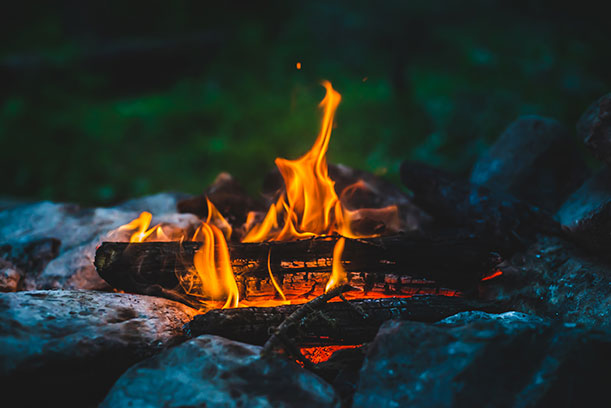BOOMbox at Home: The Element of Fire
March 24, 2021

During spring, we're exploring the four elements of earth, air, fire, and water. This week, we’re exploring fire.
Fire has always been special to humans. It helps keep us warm, and helped early humans cook their food. Fire can also be a destructive force that we have witnessed with the devastating wildfires that have happened in recent years.
So what is fire? Flames are made of carbon dioxide, water vapor, oxygen, and nitrogen. Fire needs a fuel source in order to make flames. This is known as the fuel triangle: oxygen, heat, and fuel.
Controlled Burns
Even though a fire is destructive, fire can have regenerative aspects that are extremely beneficial to nature. Controlled burns are fires started intentionally to prevent potentially catastrophic wildfires. Does it seem counterintuitive to set fire to an area to protect it? By doing a controlled burn, professionals can clear out the brush, trees, and other materials that could otherwise be fuel for wildfires. Having professionals control and stand by for the fires helps negate the risks of the fire getting out of control.
One of the most well-known benefits of controlled burns is that of sequoia trees. Sequoias need fire to open up their cones and allow their seeds to spread. Without fires, sequoias would not be able to reproduce. Fire dries out the cones that hold the seeds, which allows the seeds to fall out of the cones. The fire also clears the debris on the forest floor so the seeds can get into the ground and germinate. Controlled burns are actually nothing new. First Nation tribes located in the prairie states, as well as wooded areas, were performing controlled burns long before Europeans came to America.
Make a DIY fire extinguisher to put out a candle and learn about the science of combustion (use caution--younger scientists should have adult assistance with this project).
Mythology of Fire
There are many different origin stories of how fire became a tool for humans. Some familiar stories come from Greek mythology and First Nation origin stories. Both describe fire being stolen from one group and given to another. Read a Cherokee story called The First Fire, in which fire was stolen by a water spider who carried a small chunk of fire on her back when she crossed the river. In Greek mythology, Prometheus goes against the Greek Gods and brings fire down to the humans suffering on Earth and suffers the consequences for doing so.
Chicago Fire
Fire is also deeply connected to the city of Chicago, due to the Chicago Fire in 1871. At the time, Chicago was plagued by hot and dry weather, as well as inadequate building codes, which made it easy for a fire to spread. The fire started at the south branch of the Chicago River and jumped across to the central part of Chicago. After taking out most of the central part of Chicago, it was again able to jump to the Near Northside and decimate that part of the city as well.
One of the myths around the Chicago Fire is that it was started by a cow kicking over a lantern at the O’Leary barn, causing the fire to start on some hay. There are other stories that involve a group of men gambling, who then knocked over a lantern. The O'Leary theory was debunked several times and the story is attributed to anti-Catholic and anti-Irish sentiments during the time, and the O’Leary’s never stood trial. The fire spread quickly because most of Chicago was made of wood, including the roads.
Even though the fire destroyed many homes and left a path of destruction, a lot of good things came out of the fire as well. The building code was improved to make sure that a fire like this could not happen again. A large donation from the United Kingdom helped develop the free Chicago Public Library system. The library system before the fire was "pay to use." After the fire, the system was able to switch to free use, which helped a large number of people gain access.
Scientist of the Week
Louise Loudermilk is a fire scientist, or fire ecologist, who studies fire and how it helps nature. She currently resides in Athens, Georgia. She holds a PhD in interdisciplinary ecology from the University of Florida. Most of her work is done with spatial simulation of modeling forest ecosystems, with an emphasis on understanding/tracking tree demography to understand fire behavior. She believes that fire is a very important process, similar to sun or rain, and the need for controlled burns is paramount. She says the best way to understand controlled burns and fire science is to witness it for yourself at local preserves. She encourages young people to get interested in fire science because it is still a new field that has lots of opportunities.
Written by Erica.